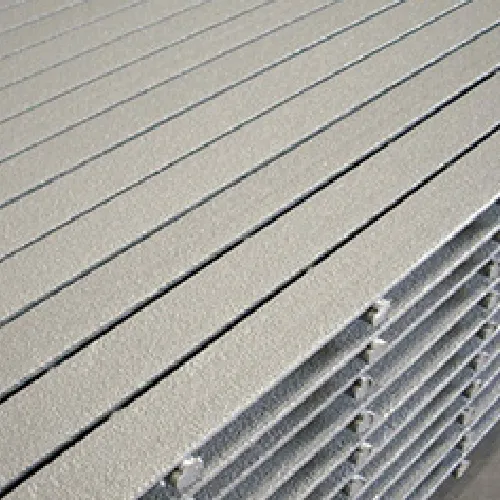loading...
- No. 9, Xingyuan South Street, Dongwaihuan Road, Zaoqiang County, Hengshui, Hebei, China
- admin@zjcomposites.com
- +86 15097380338
- Welcome to visit our website!
grp handrail systems
Introduction to GRP Handrail Systems
Glass Reinforced Plastic (GRP), also known as fiberglass, has emerged as a popular material for various applications in construction and infrastructure, especially in the production of handrail systems. GRP handrail systems are designed to offer safety, durability, and aesthetics, making them an ideal choice for both industrial and commercial environments. This article will delve into the properties, advantages, applications, and installation of GRP handrail systems, highlighting their significance in modern construction.
Properties of GRP Handrail Systems
GRP handrail systems are made from a composite material that combines glass fibers and resin, resulting in a lightweight yet strong structure. One of the primary benefits of GRP is its corrosion resistance, which makes it an excellent alternative to traditional materials like metal or wood. Unlike steel, GRP does not rust, and its strength is not compromised by environmental factors such as moisture and chemicals. This property makes GRP handrails particularly suitable for coastal or industrial environments where exposure to harsh conditions is prevalent.
Additionally, GRP handrails provide excellent impact resistance, which is crucial in environments where safety is a paramount concern. The material can absorb shocks and vibrations, reducing the likelihood of failure due to mechanical stress. This characteristic ensures that GRP handrail systems maintain their integrity over time, resulting in a long service life with minimal maintenance.
Advantages of GRP Handrail Systems
One of the standout advantages of GRP handrail systems is their low maintenance requirements. Unlike metal or wood, which may require regular painting, staining, or treatment to prevent deterioration, GRP handrails can be easily cleaned and require little to no ongoing maintenance. This feature significantly reduces long-term costs for property owners and managers.
Moreover, GRP handrail systems are highly customizable. They can be manufactured in various colors, shapes, and sizes, allowing for tailored solutions that meet specific aesthetic and functional needs. This flexibility makes GRP handrails suitable for a wide range of architectural styles and applications, from commercial buildings to residential projects.
Another compelling benefit is the sustainability aspect of GRP materials. Many manufacturers now produce GRP from recycled materials, contributing to more environmentally friendly construction practices. This aligns with the growing emphasis on sustainability in building design and construction, offering a greener alternative to conventional materials.
grp handrail systems

Applications of GRP Handrail Systems
GRP handrail systems find applications in numerous sectors. In industrial settings, they are often used in factories, warehouses, and chemical processing plants, where their corrosion resistance and strength are critical. In commercial spaces, such as shopping malls and airports, GRP handrails provide safety while enhancing the aesthetic appeal. Additionally, these handrails are commonly utilized in pedestrian bridges, balconies, and staircases, where both safety and design are imperative.
Furthermore, GRP handrails are ideal for outdoor applications, including parks, walkways, and recreational areas. Their resistance to weather and UV radiation ensures they remain functional and attractive even after prolonged exposure to the elements.
Installation of GRP Handrail Systems
The installation process of GRP handrail systems is straightforward, particularly when compared to traditional materials. The lightweight nature of GRP allows for easier handling and transportation, reducing labor costs and installation time. Additionally, the components can often be prefabricated, ensuring uniform quality and facilitating quicker installation on-site.
Proper installation is essential to maintain safety standards. It is recommended to work with experienced professionals who can ensure that the handrails are securely fixed and comply with local building codes and regulations. This attention to detail ensures that the handrail systems will provide the intended safety benefits without compromise.
Conclusion
In conclusion, GRP handrail systems are a modern solution that combines safety, durability, and design flexibility. Their resistance to corrosion, low maintenance needs, and environmental benefits make them an appealing choice for various applications across multiple industries. As construction practices increasingly prioritize sustainability and safety, GRP handrail systems are poised to become an even more integral component in the construction landscape. Whether in an industrial facility or a public space, these handrails offer practical benefits without sacrificing aesthetic appeal, making them a smart investment for any project.
-
GRP Structures: The Future of Lightweight, High-Performance EngineeringNewsJun.20,2025
-
FRP Water Tank: High-Performance Storage for Corrosive and Clean Water SystemsNewsJun.20,2025
-
FRP Square Tube: The New Industry Standard for Chemical and Structural ApplicationsNewsJun.20,2025
-
FRP Pultruded Profiles: The Ultimate Choice for Lightweight Structural StrengthNewsJun.20,2025
-
FRP Handrails: The Safer, Smarter, and Stronger Choice for Modern InfrastructureNewsJun.20,2025
-
FRP Grating: The Smart Solution for Durable, Lightweight Industrial FlooringNewsJun.20,2025
-
Why Choose a Galvanized Water Tank for Your Storage NeedsNewsMay.21,2025
